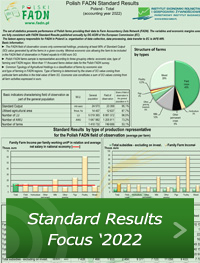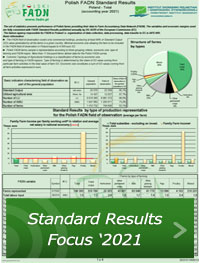What is the FSDN?
 From 2025, the EU’s FADN (Farm Accountancy Data Network) farm accounting data collection system has been transformed into the FSDN (Farm Sustainability Data Network).
From 2025, the EU’s FADN (Farm Accountancy Data Network) farm accounting data collection system has been transformed into the FSDN (Farm Sustainability Data Network).
The Farm Sustainability Data Network (FSDN) is an EU survey designed to collect farm data annually and closely follows the FADN, which for 60 years has been the only and unique source of microeconomic data collected annually from a sample of around 80 000 farms, representing 3.7 million farms and 90% of the agricultural production in the European Union.
The FSDN, which is a continuation of the FADN, will allow both a detailed assessment of the production and economic situation of farms, as well as provide the necessary environmental and social data to monitor the level of sustainability of European Union agriculture and to address the challenges facing European Union agriculture.
The FSDN, like the FADN, will play a key role in the creation, monitoring and evaluation of the Common Agricultural Policy. At the same time, it will provide the data necessary for the analysis and development of the agricultural sectors in the European Union Member States as a whole in the economic, social and environmental dimensions.
The implementation of the FSDN opens up new opportunities for broader analysis of farm performance in the area of sustainable development. The importance of the FSDN should also be emphasized in terms of developing methods of data collection based on already existing databases, e.g. public administration (interoperability of databases) and contributing to the development of a benchmarking system, i.e. comparing the performance of a given farm with that of other farms.
Who participates in the system?
Initially, agricultural holdings from the 6 founding countries participated in the system. With successive enlargements of the European Union, there were more participants in the system. Currently, the FSDN system operates in 27 Member States and more than 70 000 farms. Liaison Agencies in each country are responsible for the implementation of the FSDN.
The function of the Liaison Agency responsible for carrying out the FSDN task in Poland will continue to be performed by the Institute of Agricultural and Food Economics – National Research Institute. However, data from farms will be collected through provincial agricultural advisory centers.
What kind of data is collected under the FSDN?
The range of data currently collected in the FADN covers production and economic issues (e.g. crop area, number of animals, value of assets, value of production, costs). From 2025 onwards, this range of data will be extended to include environmental and social variables. Therefore, from 2025 onwards, the FSDN will collect data on farm management in terms of farming practices, natural fertilisers, water, energy, market integration, etc. In subsequent years, data on the use of plant protection products will also be collected in order to calculate the amount of active substances, as well as data on the use of antimicrobials.
Key assumptions of the FSDN system:
- voluntary participation of farmers in FSDN, in addition, Member States are required to develop an incentive plan for farmers to participate in FSDN,
- data cannot be used for administrative and tax audits.
- the scope of data collected includes three dimensions of sustainability (economic, environmental, social).
- maximize the use of collected data from farms according to the principle of “collect data once and use it many times” – reducing the administrative burden on farmers and Agricultural Advisory Centers through the Liaison Agency’s access to other national databases,
- The European Commission is supporting EU Member States in the process of transforming FADN into FSDN (EU financial contribution for the establishment and operation of FSDN).
Determining the size and structure of a sample of agricultural holdings for the FSDN system
Since 2015, the provisions of the Community Typology for Agricultural Holdings (WTGR) have been included in the FSDN legislation to form an integrated whole. Council Regulation (EC) No 1217/2009 setting up the Farm Sustainability Data Network is supplemented by the Commission Delegated Regulation (EU) No 1198/2014 of 1 August 2014. For more information on the legislation in the context of Community Typology, see METHODOLOGY -> TYPOLOGY -> Rules by SO.
The methodological manual applicable to the community typology (WTGR) issue is the Typology Handbook.
The classification of agricultural holdings is carried out according to two criteria:
- economic size,
- type of farming.
The economic size of a farm is determined by the sum of the Standard Outputs (SO) obtained from all the agricultural activities occurring on the farm. The type of farming of the agricultural holding is determined by the share of the Standard Output (SO) value from each group of agricultural activities in the total SO value of the farm.
SO (Standard Output) is defined as a 5-year average of the production value of a specific crop or livestock production activity obtained from 1 hectare or from 1 head of livestock in 1 year, under regionally average production conditions.
The field of observation of the European FSDN system includes commodity farms that produce about 90% of the value of Standard Output in a given region or country. The economic size thresholds determining the minimum size of farms to be included in the FSDN observation field vary from one Member State to another, primarily due to existing differences in agrarian structure. The Liaison Agencies of the individual Member States are required to develop a plan for selecting farms each time after receiving data from the Farm Structure Survey. The selection plan, developed and approved by the FSDN National Committee of a country, is forwarded to the European Commission for approval.
The Farm Return
The Liaison Agency of each Member State prepares, after the end of the accounting year, reports on farms belonging to a representative sample of farms approved by the European Commission.
The farm returns in the form of electronic files are sent to the European Commission. The scope, format and method of entering the data necessary for the FSDN farm return creation are precisely described in the relevant European Commission Regulation. These enable the creation of common data sets from farms operating within the European Union.
With regard to the farm return, the applicable methodological manual is the document FARM RETURN DATA DEFINITIONS.
FSDN Standard Results
Standard Results are a set of aggregated variables calculated from farm returns data provided by the Liaison Agencies of each member country.
Currently, all financial results are reported in euros (previously in ecu). This makes it possible to group and analyze the results of individual Member States at the Community level, as well as to directly compare results between Member States.
Reports using the Standard Results are prepared, among others, by DG-AGRI team of employees (Directorate General for Agriculture and Rural Development, Unit A.2) in the European Commission, responsible for the operation of the FSDN.
In order to prevent the identification of the individual farms from which the accounting data comes, the Commission does not publish averaged results from a group of fewer than 15 farms.
The Standard Results are publicly available on the European Commission’s website and are updated after each data revision by Member States.
For a description of the variables that make up the Standard Results, along with methodological notes, see Definitions of variables used in FSDN Standard Results.






